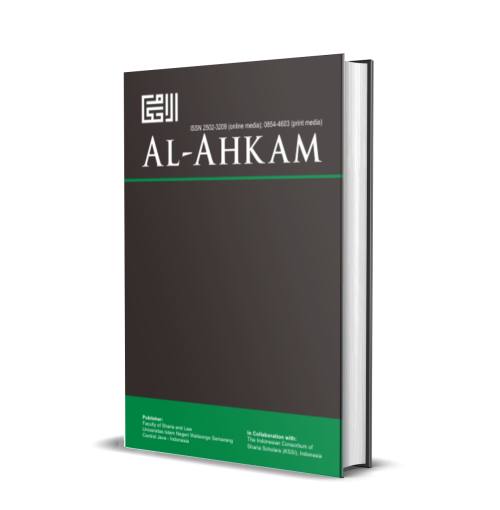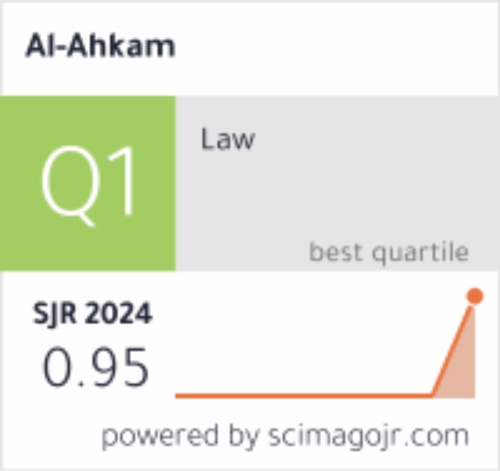SINKRONISASI PERATURAN PERUNDANG-UNDANGAN MENGENAI PERKAWINAN BEDA AGAMA
DOI:
https://doi.org/10.21580/ahkam.2013.23.1.70Keywords:
sinkronisasi horisontal, sinkronisasi vertikal, peraturan perundangundangan, perkawinan beda agamaAbstract
This study aims to know the horizontal and vertical synchronization of legislation on interfaith marriage in Indonesia. This study is a part of normative legal research which is projected to examine the harmonization of legislation regarding interfaith marriage. The current approach of this research is legislation approach (statue approach) in which the data was collected by reciting the literature of primary and secondary legal materials. The next to analysis the data, the researcher examined them through horizontal and vertical synchronization. And the last, the finding outs are : the first, it horizontally occurs discrepancies between the regulation No. 1 of 1974 on Marriage and the regulation No. 23 of 2006 on Demographic and Civic Administration. According to the marriage regulation, interfaith marriage is prohibited meanwhile Demographic and Civic Administration regulation allows it. The second, vertically, between the Marriage regulation of the Government Regulation No. 9 of 1975 and Presidential Decree No. 9 of 1991 already contained synchronization that prohibits interfaith marriage. However, the Cross Marriage Regulation No. 158 of 1898 occurred discrepancies in where Marriage regulation prohibits people to do the interfaith marriage, meanwhile according to the Cross Marriage Regulation, interfaith is not a barrier to marry.Downloads
References
Ibrahim, Johny, Teori dan Metodologi Penelitian Hukum Normatif, Malang:
Bayumedia Publising, 2006.
Instruksi Presiden No 9 Tahun 1991 tentang Kompilasi Hukum Islam.
Mahmud Marzuki, Peter, Penelitian Hukum, Jakarta: Kencana Prenada Media
Group, 2008.
Mertokusumo, Sudikno, Mengenal Hukum (Suatu Pengantar), Yogyakarta: Liberty,
Peraturan Pemerintah No. 9 Tahun 1975 tentang Pelaksanaan UU No. 1 Tahun
tentang Perkawinan.
Peraturan Perkawinan Campuran No. 158 Tahun 1898.
Rahardjo, Satjipto, Ilmu Hukum, Bandung: Citra Aditya Bhakti, 2000.
Soekanto, Soerjono dan Sri Mamuji, Penelitian Hukum Normatif, Suatu Tinjauan
Singkat, Jakarta: Rajawali Press, 1988.
Sudarsono, Hukum Perkawinan Nasional, Jakarta: Rineka Cipta, 1994.
Syahrani, Riduan, Seluk Beluk dan Asas-asas Hukum Perdata, Bandung: Alumni,
Trisnaningsih, Mudiarti, Relevansi Kepastian Hukum dalam Mengatur Perkawinan
Beda Agama di Indonesia, Bandung: Utomo, 2007.
Sinkronisasi Peraturan Perundang-undangan Mengenai Perkawinan Beda Agama
Undang-Undang No. 1 Tahun 1974 tentang Perkawinan.
Undang-Undang No. 23 Tahun 2006 tentang Administrasi Kependudukan.
Yuliandri, Asas-asas Pembentukan Peraturan Perundang-undangan yang Baik,
Jakarta: Raja Grafindo Persada, 2010.
Flora Lamandasa, Raimond, “Perkawinan Beda Agama di Indonesia”, http://www.
scrtd.com/Raimond%20flon%20lamandasa,%20my%20publised%20files,
diakses tanggal 30 Juni 2010.
http://anggara.org/2007/07/05/perkawinan-beda-agama-di-Indonesia/, diakses
Agustus 2010.
http://www.mui.or.id/mui_in/fatwa.php?id=135, diakses tanggal 30 Juli 2011.
Munir, Zaldy, “Perkawinan Beda Agama dalam Perspektif Agama-agama”, http://
zaldym.wordpress.com/2008/07/15/perkawinan-beda-agama-dalamperspektif-
agama-agama, diakses tanggal 2 September 2011.
www.vhrmedia.com/pernikahan-beda-agama-konsultasi420.html, diakses tanggal
Juli 2011.
Downloads
Published
How to Cite
Issue
Section
License
By submitting an article to the journal, the author(s) agree to transfer the published article's copyright to the journal, which will act as the publisher. This means the journal will have the right to publish the article in various forms, including reprints. The journal will maintain the publishing rights to the published articles.
In line with the license, authors and third parties (readers, researchers, and others) are allowed to share and adapt the material. In addition, the material must be given appropriate credit, provided with a link to the license, and indicated if changes were made. If authors remix, transform or build upon the material, authors must distribute their contributions under the same license as the original.




